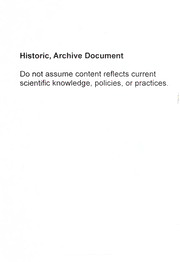
South Fork Wildlife Area PDF
Preview South Fork Wildlife Area
Historic, Archive Document Do not assume content reflects current scientific knowledge, policies, or practices. aQL84 .22 •C2S64 1998 United States Prepared by Seqi Department of Forest Nati Agriculture Service Eefe The South Fork Wildlife Area is ...part of the Great Valley Riparian Forest Ecosystem. The riverside forest, otherwise known as riparian, consists primarily of mixed willow species and Fremont’s cottonwood trees. Intermixed with these trees are dense stands of mule fat, stinging nettle, and rabbit brush. Cattails, tules, and wild celery abound in the wet area. ...home to a multitude of birds and animals. Birds of the South Fork Valley are found in great abundance and diversity. Over 315 bird species have been observed utilizing the South Fork Valley including the state endangered yellow¬ billed cuckoo, the federally endangered southwestern willow flycatcher, the summer tanager, blue grosbeak, yellow warbler, tri¬ colored blackbird, and yellow-breasted chat. Many of the birds breeding here are Neotropical migrants. These species will nest and forage in the riparian forest during the summer and then fly to South and Central America for the winter. Birds of prey that may be seen soaring over the South Fork Valley include the golden eagle, bald eagle and the osprey. Up to eight species of owls are known to use the area, including the burrowing, long-eared and barn owls. Many birders delight in the eight species of hummingbirds that have been recorded utilizing the valley. The area is also home to a variety of waterbirds, such as the double-crested cormorant, Clark’s grebe, and the northern pintail. Other bird species of special interest are the American white pelican, roadrunner, turkey vulture, great blue heron, and the belted kingfisher. Mammals found here include mule deer, beaver, coyotes, gray fox, bobcats, raccoons, and occasionally black bear and mountain lion. A sizeable population of southwestern pond turtles live in the river backwaters and ponds of the wildlife area. Migration Map For Neotropical Bird Species 193 Total breeding species in the South Fork Wildlife Area 99 Species reside here all year 94 Species migrate after breeding season 20 Species short distance migrators 34 Species migrate to Mexico 16 Species migrate to north Central America 10 Species migrate to south Central America 8 Species migrate to north South America 6 Species migrate to south South America ...a unique recreation opportunity. In addition to its wildlife values, the South Fork Wildlife Area provides unique recreational opportunities to the visitor. Fishing, hunting, canoeing, kayaking, and hiking are activities that attract recreation enthusiasts to Lake Isabella and the South Fork Wildlife Area. Birdwatchers, botanists, and teaches come to study and teach about the ecological vahies-'olythe riparian forest. Special boating and damping restrictions are in effect in the South Fork Wildlife Area to protect the wildlife values. For details regarding these restrictions, please check with the local Forest Service Ranger Station prior to visiting the Wildlife Area. Canoeing in the South Fork ...a place to enjoy, but please join us in conserving this special place. The South Fork Kern River supports a portion of the most extensive riparian* forest remaining in California. The South Fork Wildlife Area, located at the southeastern end of the Kern River Valley, is comprised of a dense growth of riparian trees and shrubs. The area’s rich alluvial soils and high water table nourishes a large portion of what remains of California’s Great Valley Riparian Forest. Less than two percent of the state’s original riparian forests survive today. The South Fork Wildlife Area is approximately 1200 acres and is managed by the Sequoia National Forest. The South Fork Wildlife Area is a part of one of the few ecosystems in North America that is at a convergence of five major bioregions, or ecologically distinct areas. Bioregions converging in this area are the Great Basin, Mojave Desert, Sierran Forest, Coastal Chaparral, and the California Grasslands/Great Valley Riparian Forest. * The term riparian refers to the habitats located on the bank of a river, creek, or lake. Cooperative Management The U. S. Forest Service manages and studies the South Fork Wildlife Area utilizing partnership agreements and cooperative relationships with Audubon-California, California Department of Fish and Game, dedicated independent wildlife biologists and researchers, South Fork Resource Conservation District, and private landowners. Credits Photographs Cover South Fork Kern River - Teresa Ritter Lesser Goldfinch - Steve Laymon Red-winged Blackbird - Steve Laymon Western Kingbird - Steve Laymon Inside South Fork Kern River - Teresa Ritter Yellow-billed Cuckoo - Ian Tait Raccoon - Steve Laymon Summer Tanager - T. and L. Bulmer Canoeing the South Fork - Sharon Leger Migration Map Information Provided by Steve Laymon (1998) American Ornithologists Union (1957) Migration Map Graphics Shari Darke, Central Printing & Graphics Printed on Recycled Paper 1st printing: September 1998 How To Get The NATIONAL AGRICULTURAL LIBRARY SEQUOL 022459341 For More Information Greenhorn Ranger District 4875 Ponderosa Drive • P. O. Box 3810 Lake Isabella, CA 93240 (760) 379-5646 Cannell Meadow Ranger District 105 Whitney Road • P. O. Box 6 Kernville, CA 93238 (760) 376-3781 Kern River Preserve Audubon-California Hwy 178 Weldon, CA 93238 (760) 378-2531 The U.S. Department of Agriculture (USDA) prohibits discrimination in all its programs and activities on the basis of race, color, national origin, gender, religion, age, disability, political beliefs, sexual orientation, and marital or family status. (Not all prohibited bases apply to all programs.) Persons with disabilities who require alternative means for communication of program information (Braille, large print, audiotape, etc.) should contact USDA's TARGET Center at 202-720-2600 (voice and TDD). To file a complaint of discrimination, write USDA, Director, Office of Civil Rights, Room 326-W, Whitten Building, 14th and Independence Avenue, SW, Washington, DC 20250-9410 or call (202) 720-5964 (voice or TDD). USDA is an equal opportunity provider and employer.
